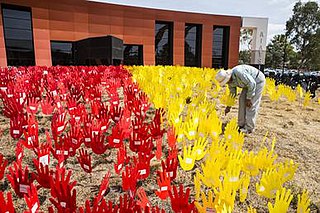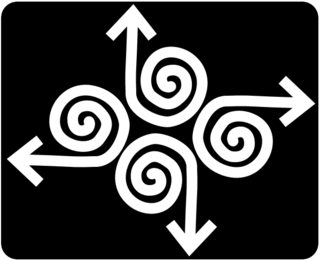Related Research Articles

Melanesian Meriam people are an Indigenous Australian group of Torres Strait Islander people who are united by a common language, strong ties of kinship and live as skilled hunter–fisher–gatherers in family groups or clans on a number of inner eastern Torres Strait Islands including Mer or Murray Island, Ugar or Stephen Island and Erub or Darnley Island. The Meriam people are perhaps best known for their involvement in the High Court of Australia's Mabo decision which fundamentally changed land law in Australia - recognising native title.

The Australian Institute of Aboriginal and Torres Strait Islander Studies (AIATSIS), established as the Australian Institute of Aboriginal Studies (AIAS) in 1964, is an independent Australian Government statutory authority. It is a collecting, publishing, and research institute and is considered to be Australia's premier resource for information about the cultures and societies of Aboriginal and Torres Strait Islander peoples.

The Gamilaraay or Kamilaroi language is a Pama–Nyungan language of the Wiradhuric subgroup found mostly in south-eastern Australia. It is the traditional language of the Gamilaraay (Kamilaroi), an Aboriginal Australian people. It has been noted as endangered, but the number of speakers grew from 87 in the 2011 Australian Census to 105 in the 2016 Australian Census. Thousands of Australians identify as Gamilaraay, and the language is taught in some schools.

Michael James Dodson is an Aboriginal Australian barrister, academic, and member of the Yawuru people in the Broome area of the southern Kimberley region of Western Australia.
William Edward Hanley Stanner CMG, often cited as W.E.H. Stanner, was an Australian anthropologist who worked extensively with Indigenous Australians. Stanner had a varied career that also included journalism in the 1930s, military service in World War II, and political advice on colonial policy in Africa and the South Pacific in the post-war period.
Ngardi, also spelt Ngarti or Ngardilj, is an Australian Aboriginal language that is considered moribund. It was previously thought to be an alternative name for the Bunara language, but these are now classified as separate languages. It was/is spoken by the Ngarti people of the Northern Territory and northern Western Australia.

The Encyclopaedia of Aboriginal Australia: Aboriginal and Torres Strait Islander history, society and culture, edited by David Horton, is an encyclopaedia published by the Aboriginal Studies Press at the Australian Institute of Aboriginal and Torres Strait Islander Studies (AIATSIS) in 1994 and available in two volumes or on CD-ROM covering all aspects of Indigenous Australians lives and world. There are 2000 entries and 1000 photographs, with the CD-ROM having 250 sound items and 40 videos.
Indigenous Australians are people with familial heritage from, and/or recognised membership of, the various ethnic groups living within the territory of present day Australia prior to British colonisation. They consist of two distinct groups, which includes many ethnic groups: the Aboriginal Australians of the mainland and many islands, including Tasmania, and the Torres Strait Islanders of the seas between Queensland and Papua New Guinea, located in Melanesia. The term Aboriginal and Torres Strait Islander peoples or the person's specific cultural group, is often preferred, though the terms First Nations of Australia, First Peoples of Australia and First Australians are also increasingly common; 812,728 people self-identified as being of Aboriginal and/or Torres Strait Islander origin in the 2021 Australian Census, representing 3.2% of the total population of Australia. Of these Indigenous Australians, 91.4% identified as Aboriginal; 4.2% identified as Torres Strait Islander; while 4.4% identified with both groups. Since 1995, the Australian Aboriginal flag and the Torres Strait Islander flag have been official flags of Australia.

Australian studies forms part of the academic field of cultural studies. It involves an examination of what constructs Australia's national identity. This area of scholarship traditionally involves the study of Australian history, society and culture but can be extended to the study of Australian politics and economics. This area of scholarship also includes the study of Australia's Indigenous population, Aboriginals and Torres Strait Islanders.

Henrietta Marrie is a Gimuy Walubara Yidinji elder, an Australian Research Council Fellow and Honorary Professor with the University of Queensland.
The Australian Indigenous HealthInfoNet, formerly National Aboriginal and Torres Strait Islander Health Clearinghouse, is an internet resource that collects, collates, interprets, and presents evidence-derived knowledge on Aboriginal and Torres Strait Islander health in Australia.
Dhauwurd Wurrung is a term used for a group of languages spoken by various groups of the Gunditjmara people of the Western District of Victoria, Australia. Keerray Woorroong is regarded by some as a separate language, by others as a dialect. The dialect continuum consisted of various lects such as Kuurn Kopan Noot, Big Wurrung, Gai Wurrung, and others. There was no traditional name for the entire dialect continuum and it has been classified and labelled differently by different linguists and researchers. The group of languages is also referred to as Gunditjmara language and the Warrnambool language.
Biri, also known as Biria, Birri Gubba, Birigaba, Wiri, Perembba and other variants, is an Australian Aboriginal language of the Mackay area of Queensland spoken by the Birri Gubba people. There are at least eight languages regarded as dialects of Biri, and two which are related but whose status is not yet fully determined. All are covered in this article.
Mary Laughren is an Australian linguist, known for her research on Australian Aboriginal languages. As of April 2018, Laughren is an Honorary Research Senior Fellow at the School of Languages and Comparative Cultural Studies at the University of Queensland.
Luise Anna Hercus, née Schwarzschild, was a German-born linguist who lived in Australia from 1954. After significant early work on Middle Indo-Aryan dialects (Prakrits) she had specialised in Australian Aboriginal languages since 1963, when she took it up as a hobby. Works authored or co-authored by her are influential, and often among the primary resource materials on many languages of Australia.

The Federal Council for the Advancement of Aborigines and Torres Strait Islanders (FCAATSI), founded in Adelaide, South Australia, as the Federal Council for Aboriginal Advancement (FCAA) on 16 February 1958, was a civil rights organisation which campaigned for the welfare of Aboriginal Australians and Torres Strait Islanders, and the first national body representing Aboriginal interests. It was influential in lobbying in favour of the 1967 Referendum on Aboriginal Australians. It was renamed to National Aboriginal and Islander Liberation Movement (NAILM) in the early to mid 1970s, before disbanding in 1978.
Cindy Anne-Maree Shannon is an Australian academic best known for her work in the field of Indigenous health.
David Robert Horton is an Australian writer who has been described as a polymath, with qualifications and careers in science and the arts. He is known for his compilation of the work The Encyclopaedia of Aboriginal Australia: Aboriginal and Torres Strait Islander history, society and culture in 1994, and its accompanying map of Aboriginal groupings across Australia.
Patricia Lynette Dudgeon, usually known as Pat Dudgeon, is an Aboriginal Australian psychologist, Fellow of the Australian Psychological Society and a research professor at the University of Western Australia's (UWA) School of Indigenous Studies. Her area of research includes Indigenous social and emotional wellbeing and suicide prevention. She is actively involved with the Aboriginal community, having an ongoing commitment to social justice for Indigenous people. Dudgeon has participated in numerous state and national committees, councils, task groups and community service activities in both a voluntary and professional capacity.
References
- ↑ AIATSIS Institute News November, 2000. Retrieved 23 July 2009
- 1 2 Land, Clare (27 April 2009). "Profile of Natascha Duschene McNamara". The Australian Women's Register. Retrieved 15 August 2009.